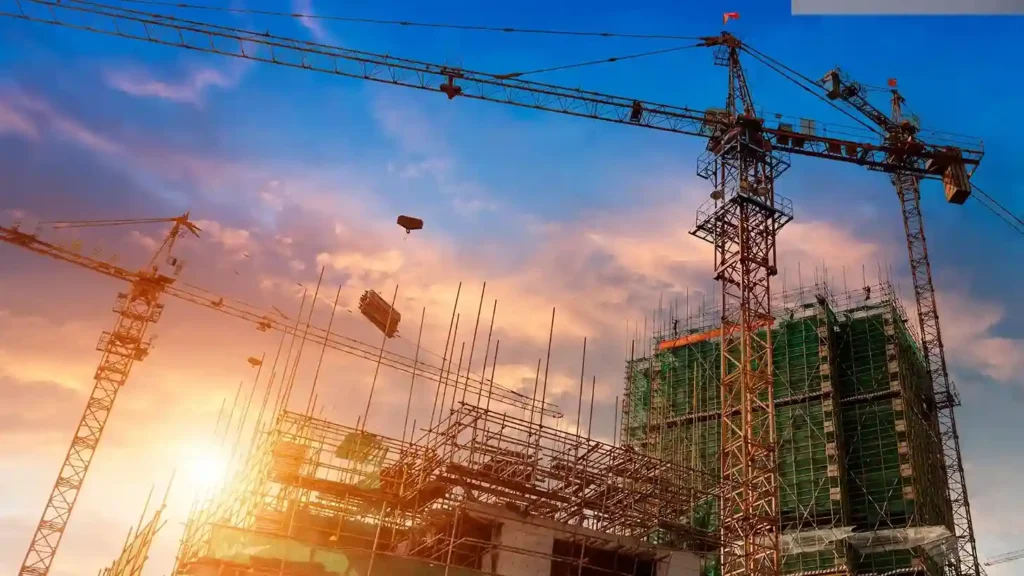
Types of Scaffolding in Construction: A Complete Guide
Scaffolding is an essential tool in the construction industry. It supports the workers, materials, and equipment on a temporary basis while ensuring that safety and access at different heights are accomplished. Whether for maintenance or painting, complex construction works require scaffolding to perform their tasks safely and effectively.
In this blog, we would discuss the various types of scaffolding in construction; we would go deeper into multiple scaffolding materials, break down the structure of scaffolding, and then explain exactly what scaffolding is. We would tell you how it is needed and explain how it boosts safety on construction sites while enhancing efficiency. If you are very new to the world of scaffolding, this article will give you a lucid understanding of the kind of scaffolding used and applications.
What is scaffolding in construction?
Let’s understand what scaffolding is, in the context of construction. Scaffolding is a temporary structure made from materials such as wood, steel, or aluminum, which provides support to workers and equipment at elevated heights. It ensures that workers can access parts of the building that are difficult to reach, such as upper floors, rooftops, or tall walls. Scaffolding also forms a safety platform to conduct works such as painting, bricklaying, or plastering.
It simply means bridging the ground and structure with scaffolding, to stabilize and safeguard them during their construction or renovation.
Types of Scaffolding in Construction
In construction, there are numerous scaffolding types, with specific applications for each one. Here are the types of scaffolding and how they are used.
1. Single Scaffolding
Single scaffolding is the most common type applied in construction, especially on brick masonry. The kind is a single row of vertical standards (poles) erected at uniform distances, with horizontal ledgers connecting them. This kind of structure is normally supported by base plates. Planks, or working platforms, are usually included for the workers to stand on.
How does single scaffolding work?
It has one row of vertical supports running along the outer side. It is placed in front of the building; it is used for a small project, where the access to the building for a single row of laborers is required. Due to its ease of setting up, it is very cost-effective and widely utilized for building scaffolding.
Advantages of Single Scaffolding
- Is easier to assemble and dismantle
- Relatively less expensive than any other type
- For small projects and low-rise buildings
Single scaffolding, commonly used in brick masonry, provides easy setup and cost-effectiveness, as explained by Civil Engineering Notes.
2. Double Scaffolding
Double scaffolding is alternatively referred to as independent scaffolding. The reason why it is known as so is that two rows of vertical standards are placed far apart. Both the rows are joined through horizontal ledgers and operate independently of the wall. Because of this arrangement, a structure becomes sturdier and stronger in nature, used for higher building construction or where immense loads are carried out.
When is double scaffolding used?
Double scaffolding is often used where single scaffolding would be insufficient for the task involved, such as stone masonry work. It also applies to building scaffolding for taller buildings with two or more stories.
Benefits of Double Scaffolding:
- Very stable and secure, especially where the work is heavy
- Double scaffolding is suitable where the building is tall, including buildings with fragile facades.
- Safeguards the laborers further
Known for its stability, double scaffolding is ideal for tall buildings and heavy work, according to Construction World.
3. Cantilever Scaffolding
Scaffolding whose platform depends on one side normally by a line of brackets and beams where the scaffold depends on this side on only one direction, depending on the second side, which is supposed to be attached to the ground. It comes in handy wherever it proves to be troublesome to mount it on something.
How and when can cantilever scaffolding be employed?
It’s mostly used in places that have unstable ground, and in cases where roads, railways, etc. cross the area. This structure is also used in locations where there is not sufficient space for support on either side of the building during scaffolding.
Benefits Cantilever Scaffolding:
- Ideal for tight locations, and difficult terrain
- Uses where scaffolding cannot support both sides of the structure
- Supports inaccessible zones
Cantilever scaffolding is used where ground support is difficult, like near roads or railways; learn its applications at Engineering Discoveries.
4. Suspended Scaffolding
Suspended scaffolding is just what it says: a scaffold platform hung from the top of the building using ropes or cables. This scaffolding is mainly used in tall buildings or structures, where the scaffold has to move up and down with the progress of the workers.
What makes suspended scaffolding different?
What is distinctive about suspended scaffolding is that it varies in height which makes it even suitable to be used while painting or cleaning or making window installation. This powered scaffolding is usually supported by either motors or sometimes controlled manually.
Benefits of Suspended Scaffolding:
- Adjusts height at will
- The best for high rise buildings and skyscrapers
- Windows and wall access for easy maintenance of windows
Perfect for high-rise buildings, suspended scaffolding offers height adjustability for painting or cleaning, as highlighted by Scaffold Training Institute.
5. Roll Scaffolding
Rolling scaffolding is the type of scaffold that remains on wheels. It’s used when there is much movement between different parts of a job site, say for electricians or painters. The rolling scaffolding is flexible and can easily be moved to any position in the job site that may require work.
How does rolling scaffolding work?
The scaffold is furnished with lockable wheels, hence it is very easy to shift from one place to the other. They are primarily used for indoor projects or low-rise outdoor structures.
Advantages of Rolling Scaffolding:
- Mobility and flexibility in ongoing tasks
- Easy shifting between different work areas
- Ideal for jobs that need mobility such as painting or repairs
Rolling scaffolding is mobile and ideal for jobs requiring frequent position changes, such as repairs or painting, as per Scaffold Access Magazine.
6. Suspended Scaffolding
A suspended scaffolding is useful when a facade or buildings on the floor are too elevated to reach from ground. It can be supported in the building through the ceiling or above floors through the help of ropes and cable. Usually, these structures are useful for the cleansing of high-rise commercial structures as well as for washing the windows.
Advantages
- Accessing areas that would not be otherwise accessible
- It may be easily utilised for special work like facade job or window cleaning
- Does not require a lot of ground space
Suspended scaffolding, ideal for high-rise buildings, allows workers to adjust heights safely for tasks like window cleaning or painting; learn more at Scaffold Industry Association
7. Trestle Scaffolding
Trestle scaffolding is lightweight scaffolding construction that is used for working at lower heights, with the provision of working environment. It consists of a platform supported on a frame of trestles, which is an A-shaped support. This kind of scaffold is normally applied in maintenance repairs for up to 5 metres of height.
Advantages of Trestle Scaffolding:
- Easy to dismantle and assemble
- Best used for low-rise projects or indoor work
- Lightweight, portable
Lightweight and portable, trestle scaffolding is best for indoor and low-height projects, detailed by Construction Tips.
Scaffolding Materials
The scaffolding materials used are a prime factor in ensuring the scaffolding is safe and sound. Some of the basic materials used in scaffolding include:
- Wood: this is the traditional scaffolding type, but it is quite rare these days because nowadays, there are stronger materials being used.
- Steel: It is the most popular material for scaffolding in terms of strength, durability, and ability to withstand heavy loads.
- Aluminum scaffolding: Lightweight and corrosion resistant, it is ideal for mobility projects.
- Bamboo scaffolding: widely used in some countries while working with bamboo scaffolding is its eco-friendliness and toughness though less popular in modern construction.
Discover materials like steel, aluminum, and bamboo, each suited to specific needs, in Scaffolding Basics.
Scaffolding Work and Items
Scaffolding work pertains to the construction, erection, and dismantling of scaffolds. Skilled manpower is necessary to make the scaffolding structure safe and secure.
The primary items of scaffolding are the following:
- Standards or poles: These are the vertical members that serve as support.
- Ledgers: These are the horizontal members connecting the standards and holding the platform.
- Braces: To give additional stability and strength.
- Planks or Decking: These are platforms where workers stand on.
- Base plates and anchors: Provide stability and anchor the scaffolding to the ground.
Conclusion
The essence of construction is scaffolding, which ensures that tasks at elevated heights are conducted safely by the workers. Amongst them, single scaffolding, double scaffolding, and suspended scaffolding provide support to the respective needs of projects. Right scaffolding ensures the smooth, safe, and timely completion of construction work. Understanding the structure, material, and work of scaffolding determines the selection of the suitable system for each construction job.
Whether you are involved in a minor building process or a great skyscraper, the knowledge about the several types of scaffolding will guide you to execute your task in a more safe and efficient manner. Remember what type of difficulty each of these scaffolding systems presents, and prioritize safety whenever you are to choose material and design for your scaffold.

FAQs on Types of Scaffolding in Construction
Q1. What are the principal types of scaffolding?
There are some principal types including single scaffolding, double scaffolding, cantilever scaffolding, suspended scaffolding, rolling scaffolding, and trestle scaffolding.
Q2. Why is scaffolding crucial?
Scaffolding allows for safe and secure work at a height, enabling workers to work efficiently on materials and equipment.
Q3. What are the main materials used in scaffolding?
Steel, aluminum, wood, and bamboo are common materials for scaffolding, though the most commonly used is steel, which has strength.



